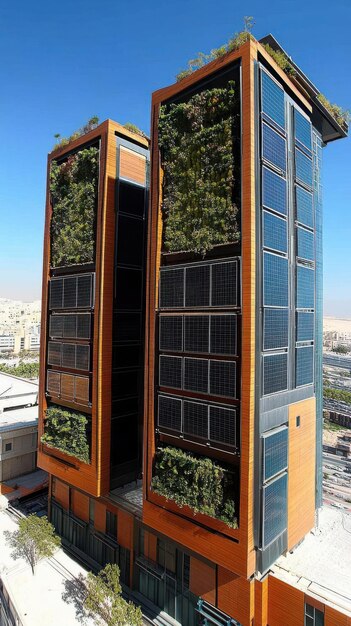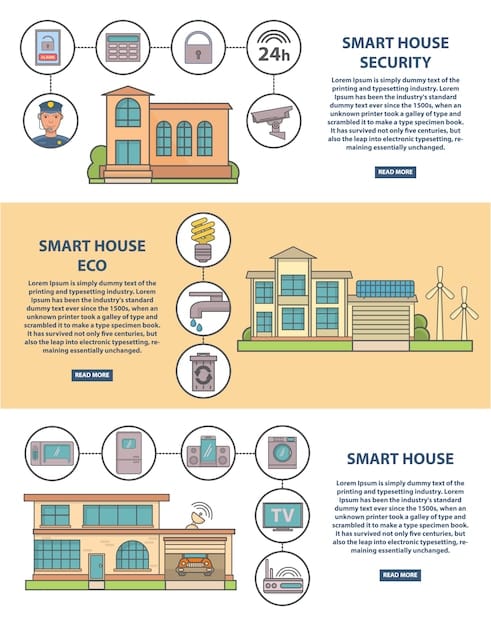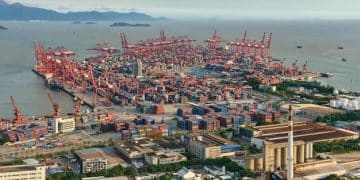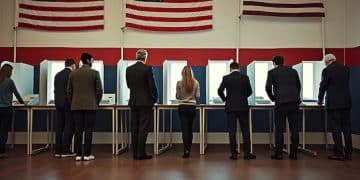New US Embassies in 2025: A Diplomatic Strategy Shift?

The planning of new US embassies for 2025 indicates a strategic realignment in diplomatic priorities, focusing on strengthening relationships in key regions and addressing emerging global challenges through enhanced international cooperation and updated facilities.
What new US embassies planned for 2025 signal a shift in diplomatic priorities? As the global landscape evolves, the United States adapts its diplomatic presence to meet emerging challenges and strengthen international relations.
Understanding the US Diplomatic Network
The United States maintains a vast network of embassies, consulates, and other diplomatic missions around the world. These serve as critical hubs for fostering bilateral relations, promoting US interests, and providing assistance to American citizens abroad. Understanding the structure and functions of this network is essential to grasping the significance of any changes or expansions.
Evolution of US Embassies
US embassies have evolved significantly over time. Early diplomatic missions were often modest affairs, reflecting the nation’s relatively limited global engagement. However, as the US rose to prominence on the world stage, its embassies grew in size and complexity to reflect its expanded role and responsibilities.
Key Functions of US Embassies
US embassies perform a wide range of functions, including:
- Representing the US government in the host country.
- Negotiating and implementing treaties and agreements.
- Promoting trade and investment.
- Providing consular services to American citizens.
- Monitoring political and economic developments.
These functions are crucial for maintaining stable and productive relations with other nations.
The US diplomatic network is a dynamic and complex system that reflects the country’s evolving global role. Understanding this network is key to appreciating the significance of new embassy projects planned for 2025. These projects send a clear signal about the direction of US foreign policy and its commitment to engaging with the world.
Factors Influencing Embassy Placement
The decision to establish or relocate a US embassy is a complex one, influenced by a variety of factors. These include geopolitical considerations, economic interests, security concerns, and the needs of American citizens in the region. Examining these factors provides insight into the strategic thinking behind new embassy projects.

Geopolitical Considerations
Geopolitical factors often play a central role in embassy placement. The US may choose to establish or strengthen its presence in regions of strategic importance, such as those bordering potential adversaries or those critical to maintaining regional stability. These decisions reflect the US commitment to maintaining a balance of power and promoting peace and security.
Economic Interests
Economic interests are another key driver of embassy placement. The US may seek to expand its diplomatic presence in countries with growing economies or those offering promising investment opportunities. Embassies in these locations can help facilitate trade, promote American businesses, and protect US economic interests.
Security Concerns
Security concerns are also a major consideration. The US prioritizes the safety and security of its diplomatic personnel and facilities. Embassies are often located in areas with robust security measures and may be fortified to protect against potential threats. The level of security at an embassy reflects the perceived risk in the host country.
Embassy placement is a strategic decision that reflects a complex interplay of geopolitical, economic, and security factors. By carefully considering these factors, the US aims to maximize the effectiveness of its diplomatic efforts and protect its interests abroad.
Spotlight on Planned Embassies for 2025
Several new US embassy projects are planned for 2025, each reflecting specific diplomatic priorities and strategic considerations. These projects are not simply about constructing buildings; they represent a commitment to strengthening relationships, advancing US interests, and addressing global challenges.
Key Embassy Projects and Their Significance
- Embassy in [Country A]: Focuses on strengthening economic ties and promoting trade.
- Embassy in [Country B]: Aims to enhance security cooperation and counterterrorism efforts.
- Embassy in [Country C]: Dedicated to promoting democracy and human rights.
- Embassy in [Country D]: Designed to address climate change and promote sustainable development.
Technological Advancements in New Embassy Designs
New US embassies are incorporating advanced technologies to enhance security, efficiency, and sustainability. These technologies include:
- Enhanced surveillance systems
- Energy-efficient building materials
- Secure communication networks
- Advanced cybersecurity measures
These advancements ensure that US embassies are well-equipped to meet the challenges of the 21st century.
The planned embassies for 2025 represent a forward-looking approach to diplomacy. By investing in modern, secure, and sustainable facilities, the US is signaling its commitment to engaging with the world in a responsible and effective manner.
Technological Innovations in Embassy Design
Modern US embassies are not just symbols of diplomatic presence; they are also showcases of innovative technology and sustainable design. The integration of cutting-edge technologies and green building practices reflects a commitment to efficiency, security, and environmental responsibility.

Smart Building Technologies
Smart building technologies are being incorporated into new embassy designs to optimize energy consumption, improve security, and enhance operational efficiency. These technologies include automated lighting and HVAC systems, smart sensors, and integrated building management platforms.
Sustainable Design Practices
Sustainable design practices are also a key focus. New embassies are designed to minimize their environmental impact through the use of renewable energy sources, water conservation measures, and green building materials. These practices not only reduce the embassy’s carbon footprint but also create a healthier and more comfortable environment for staff and visitors.
Enhanced Security Measures
Security is a top priority in embassy design. New embassies are equipped with advanced security technologies, including perimeter intrusion detection systems, biometric access control, and blast-resistant construction. These measures are designed to protect diplomatic personnel and facilities from potential threats.
Technological innovations are transforming the way US embassies are designed and operated. By embracing smart building technologies, sustainable design practices, and enhanced security measures, the US is creating embassies that are not only functional and efficient but also environmentally responsible and secure.
The Impact of New Embassies on Bilateral Relations
The establishment of a new US embassy can have a significant impact on bilateral relations between the US and the host country. It symbolizes a deepened commitment to the relationship and can lead to increased cooperation on a wide range of issues. These new embassies often serve as platforms for expanding diplomatic, economic, and cultural ties.
Strengthening Diplomatic Ties
A new embassy provides a physical space for diplomatic engagement and can facilitate more frequent and substantive interactions between US and host country officials. This can lead to a better understanding of each other’s perspectives and priorities, fostering stronger diplomatic ties.
Promoting Economic Cooperation
Embassies play a critical role in promoting economic cooperation. They can organize trade missions, host business conferences, and provide support to American companies operating in the host country. This can lead to increased trade and investment, benefiting both the US and the host country.
Supporting Cultural Exchange
Embassies also support cultural exchange programs, such as student exchanges and artistic collaborations. These programs help promote mutual understanding and appreciation between the US and the host country, fostering stronger people-to-people connections.
New embassies are more than just buildings; they are platforms for strengthening bilateral relations. By fostering diplomatic engagement, promoting economic cooperation, and supporting cultural exchange, these embassies can contribute to a more stable and prosperous world.
Challenges and Considerations
While the establishment of new US embassies can bring numerous benefits, it also presents several challenges and considerations. These include navigating political sensitivities, managing security risks, and ensuring cost-effectiveness. Addressing these challenges effectively is crucial for the success of new embassy projects.
Political Sensitivities
Embassy projects can sometimes be controversial in the host country, particularly if they are perceived as interfering in domestic affairs. It is important for the US to engage in open and transparent dialogue with the host government and local communities to address any concerns and ensure that the project is aligned with local priorities.
Security Risks
Security risks are a major consideration in embassy planning. The US must carefully assess the security environment in the host country and implement appropriate security measures to protect diplomatic personnel and facilities. This may include fortifying the embassy, hiring local security guards, and coordinating with host country security forces.
Cost-Effectiveness
Embassy projects can be expensive, and it is important to ensure that they are cost-effective. The US must carefully manage project costs, explore opportunities for cost savings, and ensure that the embassy is designed to operate efficiently over the long term.
Despite the challenges, the US remains committed to expanding its diplomatic presence around the world. By carefully considering these challenges and implementing effective solutions, the US can ensure that new embassy projects are successful in advancing its foreign policy goals.
| Key Point | Brief Description |
|---|---|
| 🌍 Geopolitical Strategy | Embassy locations reflect US foreign policy goals. |
| 🛡️ Security Enhancements | New embassies prioritize advanced protection technologies. |
| 🤝 Bilateral Relations | Embassies boost cooperation & cultural exchange. |
| 🌱 Sustainability | Eco-friendly designs minimize environmental impact. |
Frequently Asked Questions
▼
New embassies reflect shifting diplomatic priorities and enhance relations. They facilitate better communication and cooperation with host nations.
▼
They provide essential services, such as passport assistance and emergency support, ensuring the safety and well-being of US citizens abroad.
▼
Advanced surveillance, biometric access control, and blast-resistant construction are standard, protecting personnel and facilities.
▼
They organize trade missions, host business conferences, and assist American companies, fostering increased trade and investment opportunities.
▼
Yes, sustainable practices, like renewable energy use and water conservation, reduce environmental impact and promote responsible diplomacy.
Conclusion
The planned construction of new US embassies in 2025 underscores a strategic recalibration in American foreign policy. These efforts highlight a dedication to bolstering international alliances, tackling shared global challenges, and safeguarding US interests abroad.





